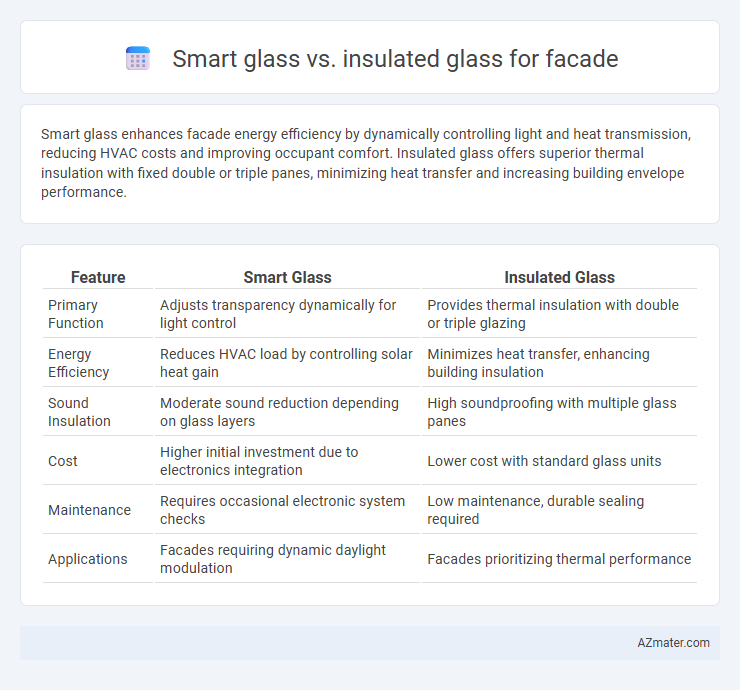Smart glass enhances facade energy efficiency by dynamically controlling light and heat transmission, reducing HVAC costs and improving occupant comfort. Insulated glass offers superior thermal insulation with fixed double or triple panes, minimizing heat transfer and increasing building envelope performance.
Table of Comparison
| Feature | Smart Glass | Insulated Glass |
|---|---|---|
| Primary Function | Adjusts transparency dynamically for light control | Provides thermal insulation with double or triple glazing |
| Energy Efficiency | Reduces HVAC load by controlling solar heat gain | Minimizes heat transfer, enhancing building insulation |
| Sound Insulation | Moderate sound reduction depending on glass layers | High soundproofing with multiple glass panes |
| Cost | Higher initial investment due to electronics integration | Lower cost with standard glass units |
| Maintenance | Requires occasional electronic system checks | Low maintenance, durable sealing required |
| Applications | Facades requiring dynamic daylight modulation | Facades prioritizing thermal performance |
Introduction to Smart Glass and Insulated Glass
Smart glass employs advanced technologies like electrochromic, thermochromic, or photochromic coatings to control light transmission and heat flow, enhancing energy efficiency and occupant comfort in facades. Insulated glass consists of two or more glass panes separated by a spacer and sealed to create an air or gas-filled cavity, providing superior thermal insulation and soundproofing. Both smart glass and insulated glass optimize building performance but serve different functions: smart glass dynamically adjusts transparency while insulated glass primarily reduces heat transfer.
How Smart Glass Works
Smart glass operates by altering its light transmission properties using technologies such as electrochromic, photochromic, or thermochromic materials, enabling dynamic control over heat and sunlight penetration. This adaptive mechanism helps reduce glare and solar heat gain, enhancing a building facade's energy efficiency and occupant comfort. Unlike insulated glass, which primarily provides thermal insulation through multiple panes and gas fills, smart glass actively modulates transparency to respond to environmental changes.
Key Features of Insulated Glass
Insulated glass features two or more glass panes separated by a sealed air space, significantly enhancing thermal insulation and reducing energy consumption in building facades. Its key components include low-emissivity coatings and gas fills such as argon or krypton, which improve U-values and minimize heat transfer. This durable configuration also provides superior sound insulation and condensation resistance compared to standard single or smart glass units.
Energy Efficiency Comparison
Smart glass and insulated glass both enhance facade energy efficiency but function differently; smart glass dynamically adjusts solar heat gain by changing tint based on external conditions, reducing cooling loads and glare. Insulated glass, usually double or triple glazed with gas fills, minimizes heat transfer through thermal resistance, maintaining stable indoor temperatures and lowering heating and cooling demands. Smart glass offers adaptive control ideal for climates with variable sunlight, while insulated glass provides consistent insulation performance across seasons.
Visual and Aesthetic Benefits
Smart glass offers dynamic control over light transmission and glare reduction, enhancing the visual comfort and aesthetic appeal of facades by allowing adaptability to changing environmental conditions. Insulated glass provides consistent thermal insulation with a clear, unobstructed view, ensuring high transparency and natural daylight without compromising energy efficiency. Both technologies contribute to modern facade design, with smart glass prioritizing interactive aesthetics and insulated glass emphasizing clarity and energy conservation.
Acoustic Performance for Facades
Smart glass offers advanced acoustic insulation by dynamically adjusting its tint and layered coatings to reduce external noise, making it ideal for urban facades exposed to traffic and construction sounds. Insulated glass units (IGUs), composed of dual or triple panes separated by air or gas-filled spaces, provide effective soundproofing by creating barriers that significantly diminish airborne noise transmission. Facades incorporating IGUs typically achieve higher sound transmission class (STC) ratings, while smart glass adds the benefit of adaptive light control without compromising acoustic performance.
Cost Analysis: Smart Glass vs Insulated Glass
Smart glass typically incurs higher upfront costs compared to insulated glass due to advanced materials and embedded technologies like electrochromic or thermochromic layers. Insulated glass offers a more cost-effective solution by combining two or more glass panes with a sealed air or gas-filled space to improve thermal efficiency at a lower price point. Long-term savings from smart glass arise through energy management and reduced HVAC loads, whereas insulated glass primarily provides baseline insulation benefits with limited adaptive capabilities.
Installation and Maintenance Considerations
Smart glass installation requires integrating electronic components such as wiring and control systems, which can complicate the process compared to insulated glass that mainly involves standard double or triple glazing units. Maintenance of smart glass demands periodic checks on electrical functionality and occasional calibration to ensure optimal performance, while insulated glass primarily requires inspection for seal integrity and moisture accumulation. Choosing between the two depends on balancing the complexity of installation and upkeep with desired energy efficiency and user control.
Environmental Impact and Sustainability
Smart glass enhances facade sustainability by dynamically controlling solar heat gain and natural daylight, reducing energy consumption for heating, cooling, and lighting. Insulated glass improves thermal performance with multiple glazing layers and gas fills, minimizing heat transfer and increasing energy efficiency in building envelopes. While both contribute to environmental impact reduction, smart glass offers adaptive control that optimizes energy savings more effectively than conventional insulated glass units.
Choosing the Optimal Solution for Your Building Facade
Smart glass offers dynamic control over light and heat transmission, enhancing energy efficiency and occupant comfort by adapting to changing environmental conditions. Insulated glass provides superior thermal insulation through double or triple glazing, reducing heat loss and improving HVAC performance for building facades. Selecting the optimal solution depends on factors such as climate, energy goals, and budget, with smart glass excelling in climates with fluctuating sunlight and insulated glass preferred for consistent thermal regulation.

Infographic: Smart glass vs Insulated glass for Facade
 azmater.com
azmater.com